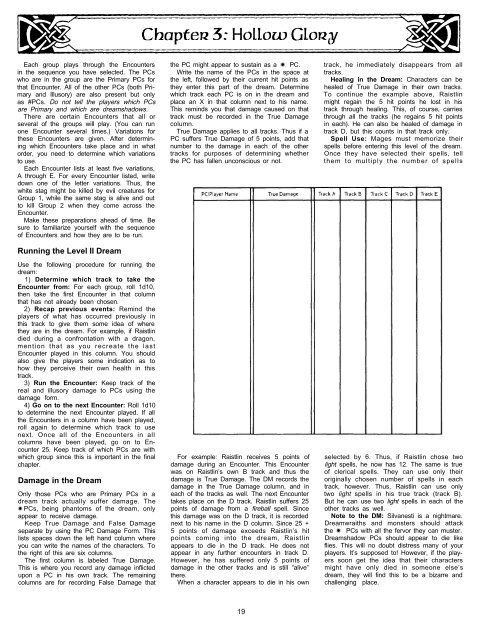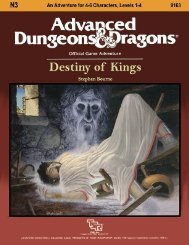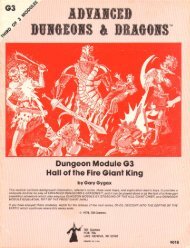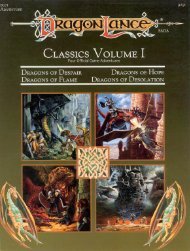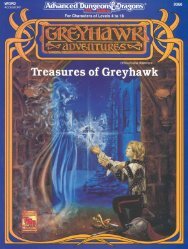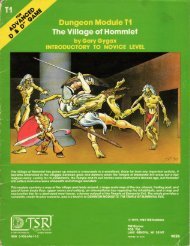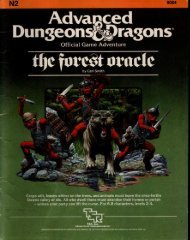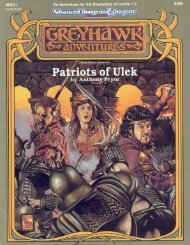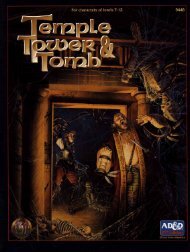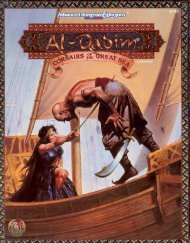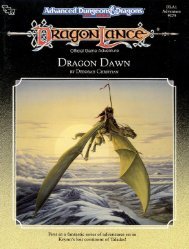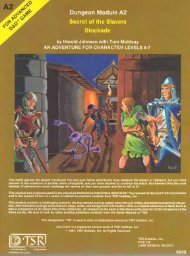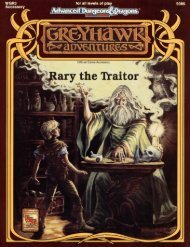DRAGONLANCE® Classics, Volume 3 - Free
DRAGONLANCE® Classics, Volume 3 - Free
DRAGONLANCE® Classics, Volume 3 - Free
Create successful ePaper yourself
Turn your PDF publications into a flip-book with our unique Google optimized e-Paper software.
Each group plays through the Encounters<br />
in the sequence you have selected. The PCs<br />
who are in the group are the Primary PCs for<br />
that Encounter. All of the other PCs (both Primary<br />
and Illusory) are also present but only<br />
as #PCs. Do not tell the players which PCs<br />
are Primary and which are dreamshadows.<br />
There are certain Encounters that all or<br />
several of the groups will play. (You can run<br />
one Encounter several times.) Variations for<br />
these Encounters are given. After determining<br />
which Encounters take place and in what<br />
order, you need to determine which variations<br />
to use.<br />
Each Encounter lists at least five variations,<br />
A through E. For every Encounter listed, write<br />
down one of the letter variations. Thus, the<br />
white stag might be killed by evil creatures for<br />
Group 1, while the same stag is alive and out<br />
to kill Group 2 when they come across the<br />
Encounter.<br />
Make these preparations ahead of time. Be<br />
sure to familiarize yourself with the sequence<br />
of Encounters and how they are to be run.<br />
Running the Level II Dream<br />
Use the following procedure for running the<br />
dream:<br />
1) Determine which track to take the<br />
Encounter from: For each group, roll 1d10,<br />
then take the first Encounter in that column<br />
that has not already been chosen.<br />
2) Recap previous events: Remind the<br />
players of what has occurred previously in<br />
this track to give them some idea of where<br />
they are in the dream. For example, if Raistlin<br />
died during a confrontation with a dragon,<br />
mention that as you recreate the last<br />
Encounter played in this column. You should<br />
also give the players some indication as to<br />
how they perceive their own health in this<br />
track.<br />
3) Run the Encounter: Keep track of the<br />
real and illusory damage to PCs using the<br />
damage form.<br />
4) Go on to the next Encounter: Roll 1d10<br />
to determine the next Encounter played. If all<br />
the Encounters in a column have been played,<br />
roll again to determine which track to use<br />
next. Once all of the Encounters in all<br />
columns have been played, go on to Encounter<br />
25. Keep track of which PCs are with<br />
which group since this is important in the final<br />
chapter.<br />
Damage in the Dream<br />
Only those PCs who are Primary PCs in a<br />
dream track actually suffer damage. The<br />
PCs, being phantoms of the dream, only<br />
appear to receive damage.<br />
Keep True Damage and False Damage<br />
separate by using the PC Damage Form. This<br />
lists spaces down the left hand column where<br />
you can write the names of the characters. To<br />
the right of this are six columns.<br />
The first column is labeled True Damage.<br />
This is where you record any damage inflicted<br />
upon a PC in his own track. The remaining<br />
columns are for recording False Damage that<br />
the PC might appear to sustain as a PC.<br />
Write the name of the PCs in the space at<br />
the left, followed by their current hit points as<br />
they enter this part of the dream. Determine<br />
which track each PC is on in the dream and<br />
place an X in that column next to his name.<br />
This reminds you that damage caused on that<br />
track must be recorded in the True Damage<br />
column.<br />
True Damage applies to all tracks. Thus if a<br />
PC suffers True Damage of 5 points, add that<br />
number to the damage in each of the other<br />
tracks for purposes of determining whether<br />
the PC has fallen unconscious or not.<br />
For example: Raistlin receives 5 points of<br />
damage during an Encounter. This Encounter<br />
was on Raistlin’s own B track and thus the<br />
damage is True Damage. The DM records the<br />
damage in the True Damage column, and in<br />
each of the tracks as well. The next Encounter<br />
takes place on the D track. Raistlin suffers 25<br />
points of damage from a fireball spell. Since<br />
this damage was on the D track, it is recorded<br />
next to his name in the D column. Since 25 +<br />
5 points of damage exceeds Raistlin’s hit<br />
points coming into the dream, Raistlin<br />
appears to die in the D track. He does not<br />
appear in any further encounters in track D.<br />
However, he has suffered only 5 points of<br />
damage in the other tracks and is still “alive”<br />
there.<br />
When a character appears to die in his own<br />
19<br />
track, he immediately disappears from all<br />
tracks.<br />
Healing in the Dream: Characters can be<br />
healed of True Damage in their own tracks.<br />
To continue the example above, Raistlin<br />
might regain the 5 hit points he lost in his<br />
track through healing. This, of course, carries<br />
through all the tracks (he regains 5 hit points<br />
in each). He can also be healed of damage in<br />
track D, but this counts in that track only.<br />
Spell Use: Mages must memorize their<br />
spells before entering this level of the dream.<br />
Once they have selected their spells, tell<br />
them to multiply the number of spells<br />
selected by 6. Thus, if Raistlin chose two<br />
light spells, he now has 12. The same is true<br />
of clerical spells. They can use only their<br />
originally chosen number of spells in each<br />
track, however. Thus, Raistlin can use only<br />
two light spells in his true track (track B).<br />
But he can use two light spells in each of the<br />
other tracks as well.<br />
Note to the DM: Silvanesti is a nightmare.<br />
Dreamwraiths and monsters should attack<br />
the PCs with all the fervor they can muster.<br />
Dreamshadow PCs should appear to die like<br />
flies. This will no doubt distress many of your<br />
players. It’s supposed to! However, if the players<br />
soon get the idea that their characters<br />
might have only died in someone else’s<br />
dream, they will find this to be a bizarre and<br />
challenging place.


